MatchBox Architect: Innovation, Creativity, and Sustainability
VerifiedAdded on 2023/06/07
|21
|5690
|264
Report
AI Summary
This report examines the concepts of corporate innovation and creativity and their importance in creating sustainable business practices, with a specific focus on MatchBox Architect. It reviews literature on innovative entrepreneurship, the role of innovation and creativity in business, and Schumpeter’s theory of innovation. The report applies these concepts to MatchBox Architect, highlighting the importance of creativity and innovation in the architectural field. Recommendations are made for the organization, including change management strategies, employee engagement initiatives, training programs, and the importance of strong leadership, all aimed at fostering a culture of sustainable innovation and creativity within the company.
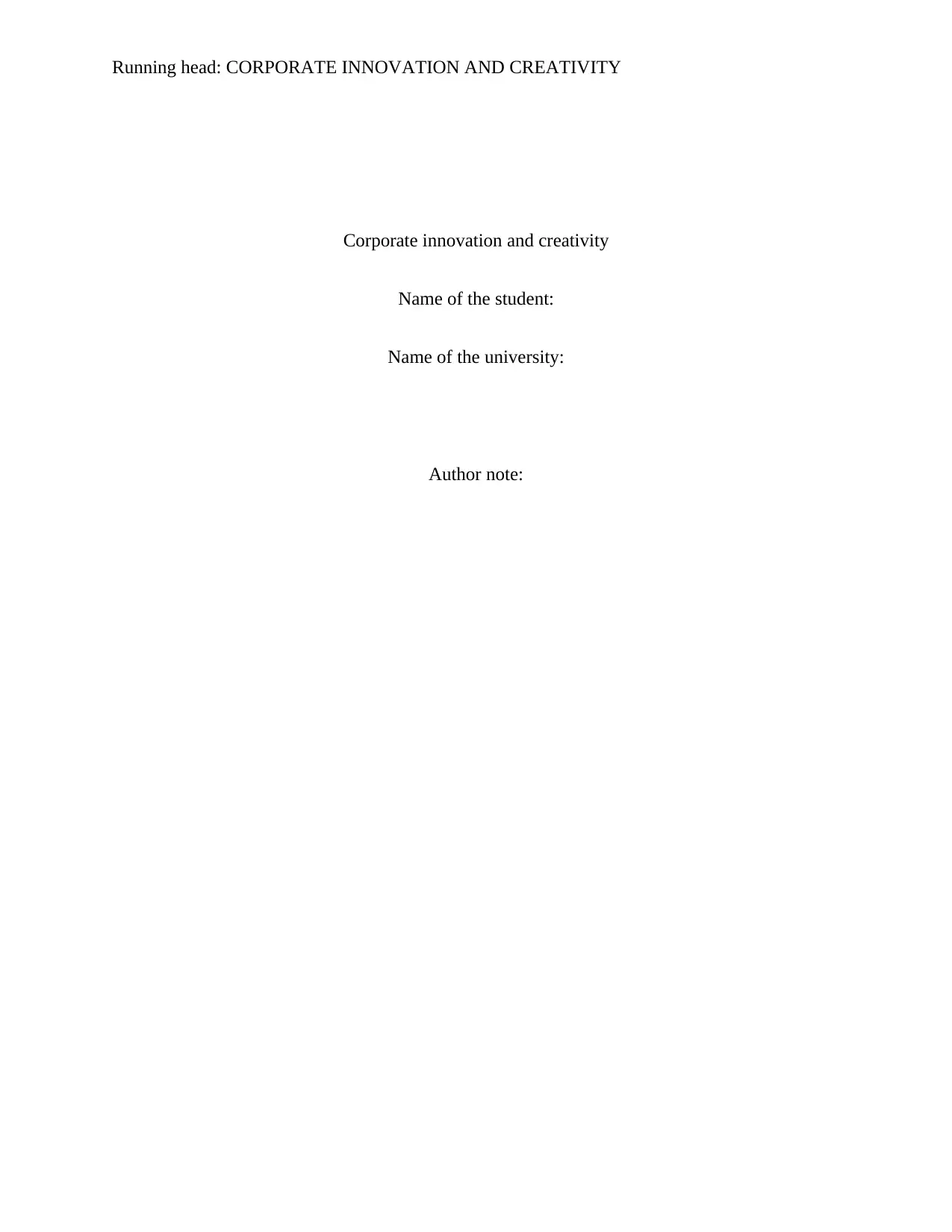
Running head: CORPORATE INNOVATION AND CREATIVITY
Corporate innovation and creativity
Name of the student:
Name of the university:
Author note:
Corporate innovation and creativity
Name of the student:
Name of the university:
Author note:
Paraphrase This Document
Need a fresh take? Get an instant paraphrase of this document with our AI Paraphraser
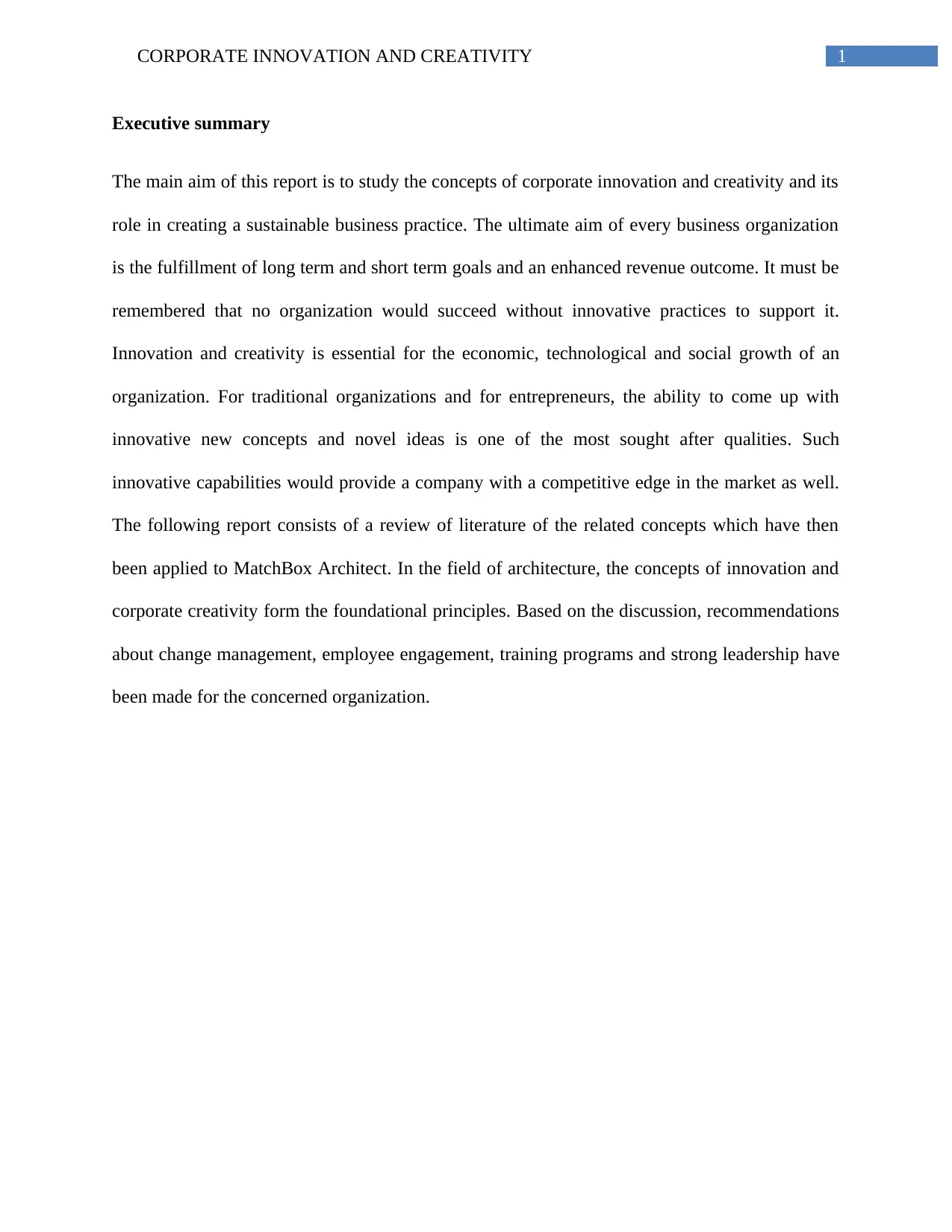
1CORPORATE INNOVATION AND CREATIVITY
Executive summary
The main aim of this report is to study the concepts of corporate innovation and creativity and its
role in creating a sustainable business practice. The ultimate aim of every business organization
is the fulfillment of long term and short term goals and an enhanced revenue outcome. It must be
remembered that no organization would succeed without innovative practices to support it.
Innovation and creativity is essential for the economic, technological and social growth of an
organization. For traditional organizations and for entrepreneurs, the ability to come up with
innovative new concepts and novel ideas is one of the most sought after qualities. Such
innovative capabilities would provide a company with a competitive edge in the market as well.
The following report consists of a review of literature of the related concepts which have then
been applied to MatchBox Architect. In the field of architecture, the concepts of innovation and
corporate creativity form the foundational principles. Based on the discussion, recommendations
about change management, employee engagement, training programs and strong leadership have
been made for the concerned organization.
Executive summary
The main aim of this report is to study the concepts of corporate innovation and creativity and its
role in creating a sustainable business practice. The ultimate aim of every business organization
is the fulfillment of long term and short term goals and an enhanced revenue outcome. It must be
remembered that no organization would succeed without innovative practices to support it.
Innovation and creativity is essential for the economic, technological and social growth of an
organization. For traditional organizations and for entrepreneurs, the ability to come up with
innovative new concepts and novel ideas is one of the most sought after qualities. Such
innovative capabilities would provide a company with a competitive edge in the market as well.
The following report consists of a review of literature of the related concepts which have then
been applied to MatchBox Architect. In the field of architecture, the concepts of innovation and
corporate creativity form the foundational principles. Based on the discussion, recommendations
about change management, employee engagement, training programs and strong leadership have
been made for the concerned organization.
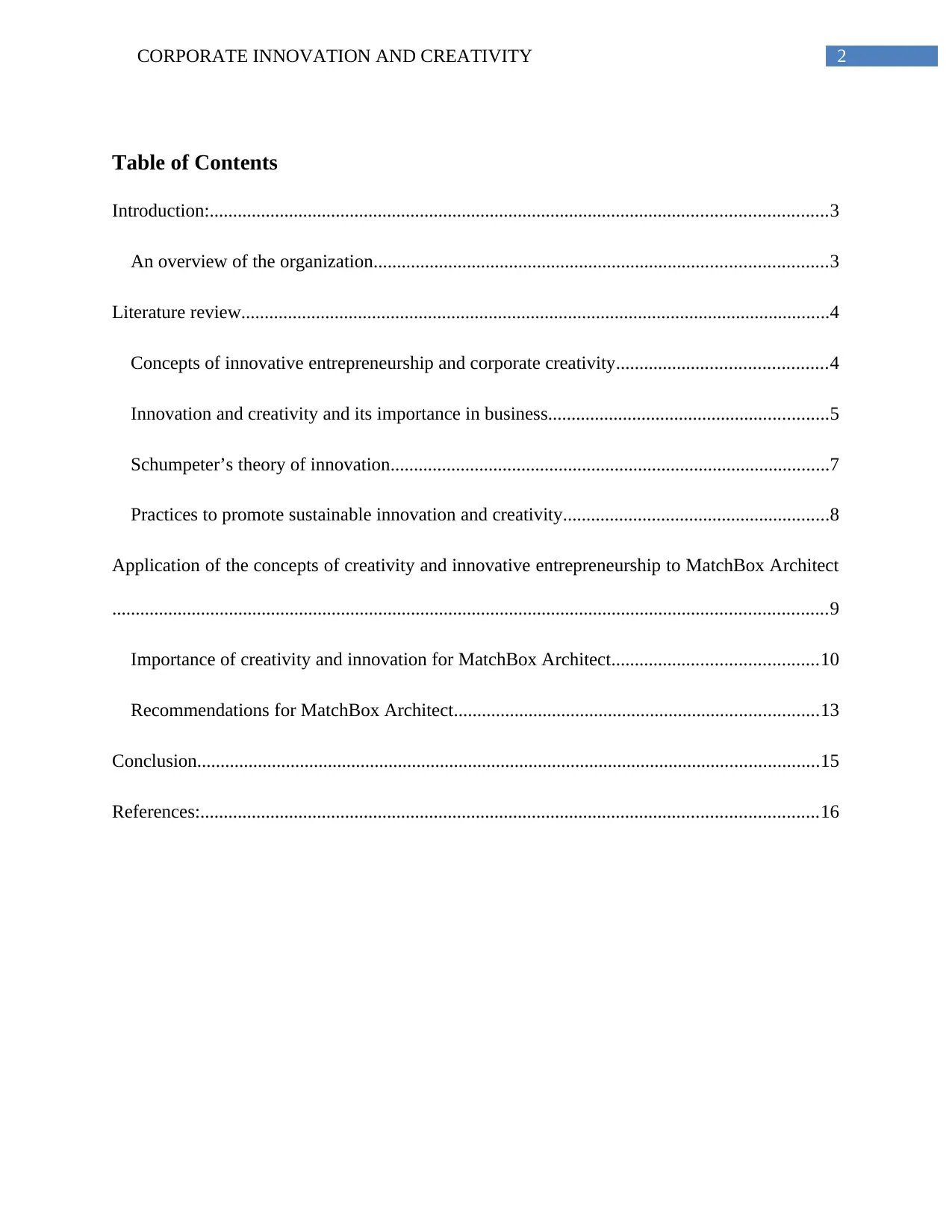
2CORPORATE INNOVATION AND CREATIVITY
Table of Contents
Introduction:....................................................................................................................................3
An overview of the organization.................................................................................................3
Literature review..............................................................................................................................4
Concepts of innovative entrepreneurship and corporate creativity.............................................4
Innovation and creativity and its importance in business............................................................5
Schumpeter’s theory of innovation..............................................................................................7
Practices to promote sustainable innovation and creativity.........................................................8
Application of the concepts of creativity and innovative entrepreneurship to MatchBox Architect
.........................................................................................................................................................9
Importance of creativity and innovation for MatchBox Architect............................................10
Recommendations for MatchBox Architect..............................................................................13
Conclusion.....................................................................................................................................15
References:....................................................................................................................................16
Table of Contents
Introduction:....................................................................................................................................3
An overview of the organization.................................................................................................3
Literature review..............................................................................................................................4
Concepts of innovative entrepreneurship and corporate creativity.............................................4
Innovation and creativity and its importance in business............................................................5
Schumpeter’s theory of innovation..............................................................................................7
Practices to promote sustainable innovation and creativity.........................................................8
Application of the concepts of creativity and innovative entrepreneurship to MatchBox Architect
.........................................................................................................................................................9
Importance of creativity and innovation for MatchBox Architect............................................10
Recommendations for MatchBox Architect..............................................................................13
Conclusion.....................................................................................................................................15
References:....................................................................................................................................16
⊘ This is a preview!⊘
Do you want full access?
Subscribe today to unlock all pages.

Trusted by 1+ million students worldwide
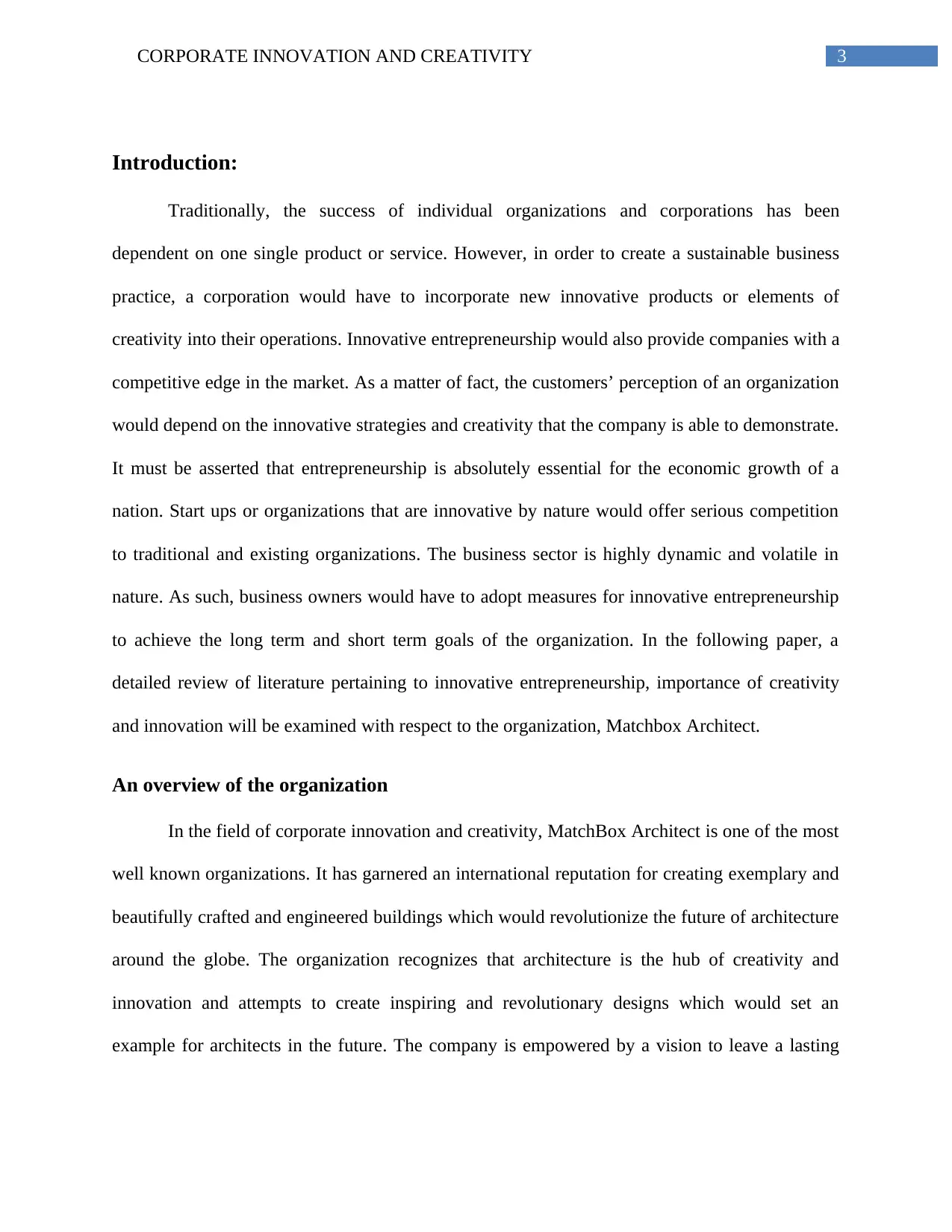
3CORPORATE INNOVATION AND CREATIVITY
Introduction:
Traditionally, the success of individual organizations and corporations has been
dependent on one single product or service. However, in order to create a sustainable business
practice, a corporation would have to incorporate new innovative products or elements of
creativity into their operations. Innovative entrepreneurship would also provide companies with a
competitive edge in the market. As a matter of fact, the customers’ perception of an organization
would depend on the innovative strategies and creativity that the company is able to demonstrate.
It must be asserted that entrepreneurship is absolutely essential for the economic growth of a
nation. Start ups or organizations that are innovative by nature would offer serious competition
to traditional and existing organizations. The business sector is highly dynamic and volatile in
nature. As such, business owners would have to adopt measures for innovative entrepreneurship
to achieve the long term and short term goals of the organization. In the following paper, a
detailed review of literature pertaining to innovative entrepreneurship, importance of creativity
and innovation will be examined with respect to the organization, Matchbox Architect.
An overview of the organization
In the field of corporate innovation and creativity, MatchBox Architect is one of the most
well known organizations. It has garnered an international reputation for creating exemplary and
beautifully crafted and engineered buildings which would revolutionize the future of architecture
around the globe. The organization recognizes that architecture is the hub of creativity and
innovation and attempts to create inspiring and revolutionary designs which would set an
example for architects in the future. The company is empowered by a vision to leave a lasting
Introduction:
Traditionally, the success of individual organizations and corporations has been
dependent on one single product or service. However, in order to create a sustainable business
practice, a corporation would have to incorporate new innovative products or elements of
creativity into their operations. Innovative entrepreneurship would also provide companies with a
competitive edge in the market. As a matter of fact, the customers’ perception of an organization
would depend on the innovative strategies and creativity that the company is able to demonstrate.
It must be asserted that entrepreneurship is absolutely essential for the economic growth of a
nation. Start ups or organizations that are innovative by nature would offer serious competition
to traditional and existing organizations. The business sector is highly dynamic and volatile in
nature. As such, business owners would have to adopt measures for innovative entrepreneurship
to achieve the long term and short term goals of the organization. In the following paper, a
detailed review of literature pertaining to innovative entrepreneurship, importance of creativity
and innovation will be examined with respect to the organization, Matchbox Architect.
An overview of the organization
In the field of corporate innovation and creativity, MatchBox Architect is one of the most
well known organizations. It has garnered an international reputation for creating exemplary and
beautifully crafted and engineered buildings which would revolutionize the future of architecture
around the globe. The organization recognizes that architecture is the hub of creativity and
innovation and attempts to create inspiring and revolutionary designs which would set an
example for architects in the future. The company is empowered by a vision to leave a lasting
Paraphrase This Document
Need a fresh take? Get an instant paraphrase of this document with our AI Paraphraser
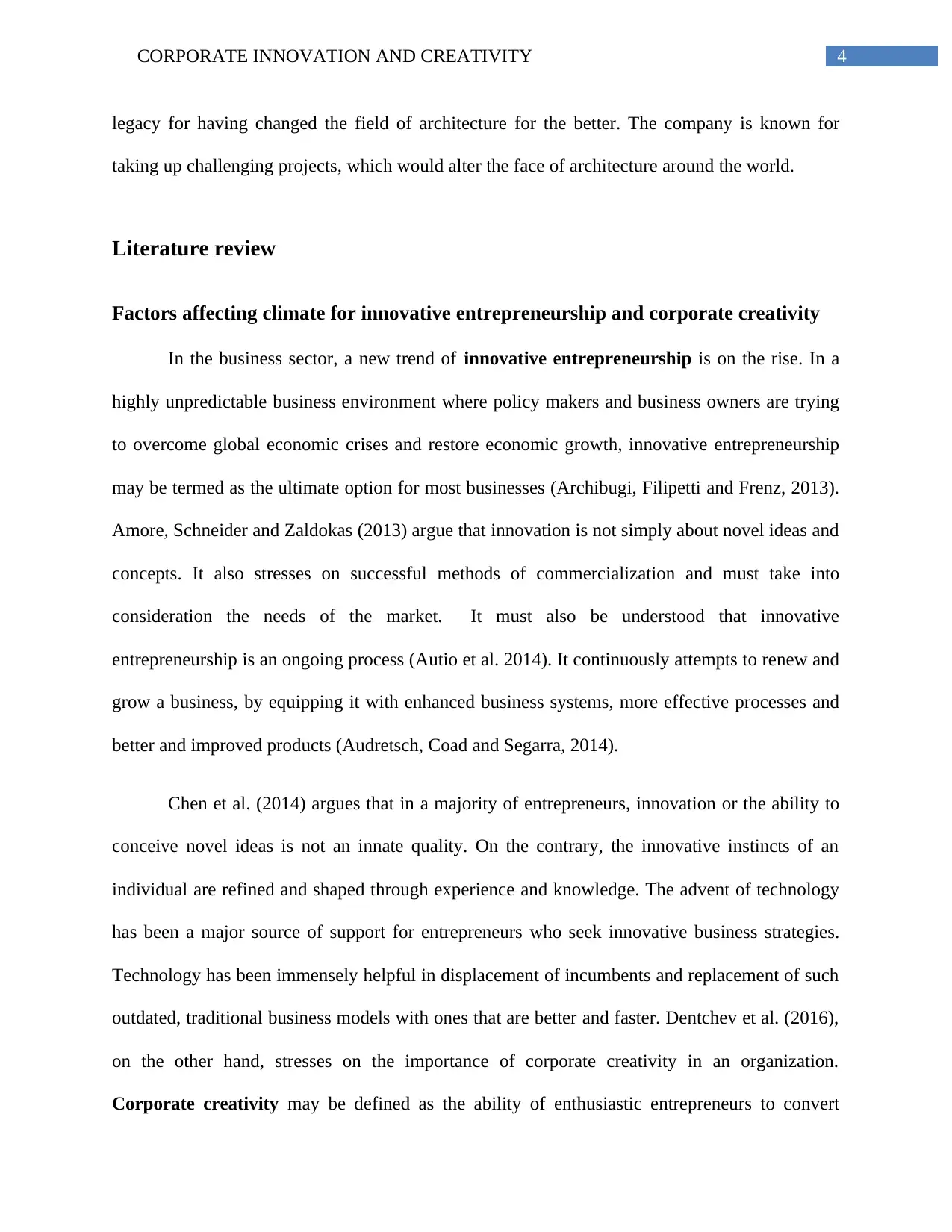
4CORPORATE INNOVATION AND CREATIVITY
legacy for having changed the field of architecture for the better. The company is known for
taking up challenging projects, which would alter the face of architecture around the world.
Literature review
Factors affecting climate for innovative entrepreneurship and corporate creativity
In the business sector, a new trend of innovative entrepreneurship is on the rise. In a
highly unpredictable business environment where policy makers and business owners are trying
to overcome global economic crises and restore economic growth, innovative entrepreneurship
may be termed as the ultimate option for most businesses (Archibugi, Filipetti and Frenz, 2013).
Amore, Schneider and Zaldokas (2013) argue that innovation is not simply about novel ideas and
concepts. It also stresses on successful methods of commercialization and must take into
consideration the needs of the market. It must also be understood that innovative
entrepreneurship is an ongoing process (Autio et al. 2014). It continuously attempts to renew and
grow a business, by equipping it with enhanced business systems, more effective processes and
better and improved products (Audretsch, Coad and Segarra, 2014).
Chen et al. (2014) argues that in a majority of entrepreneurs, innovation or the ability to
conceive novel ideas is not an innate quality. On the contrary, the innovative instincts of an
individual are refined and shaped through experience and knowledge. The advent of technology
has been a major source of support for entrepreneurs who seek innovative business strategies.
Technology has been immensely helpful in displacement of incumbents and replacement of such
outdated, traditional business models with ones that are better and faster. Dentchev et al. (2016),
on the other hand, stresses on the importance of corporate creativity in an organization.
Corporate creativity may be defined as the ability of enthusiastic entrepreneurs to convert
legacy for having changed the field of architecture for the better. The company is known for
taking up challenging projects, which would alter the face of architecture around the world.
Literature review
Factors affecting climate for innovative entrepreneurship and corporate creativity
In the business sector, a new trend of innovative entrepreneurship is on the rise. In a
highly unpredictable business environment where policy makers and business owners are trying
to overcome global economic crises and restore economic growth, innovative entrepreneurship
may be termed as the ultimate option for most businesses (Archibugi, Filipetti and Frenz, 2013).
Amore, Schneider and Zaldokas (2013) argue that innovation is not simply about novel ideas and
concepts. It also stresses on successful methods of commercialization and must take into
consideration the needs of the market. It must also be understood that innovative
entrepreneurship is an ongoing process (Autio et al. 2014). It continuously attempts to renew and
grow a business, by equipping it with enhanced business systems, more effective processes and
better and improved products (Audretsch, Coad and Segarra, 2014).
Chen et al. (2014) argues that in a majority of entrepreneurs, innovation or the ability to
conceive novel ideas is not an innate quality. On the contrary, the innovative instincts of an
individual are refined and shaped through experience and knowledge. The advent of technology
has been a major source of support for entrepreneurs who seek innovative business strategies.
Technology has been immensely helpful in displacement of incumbents and replacement of such
outdated, traditional business models with ones that are better and faster. Dentchev et al. (2016),
on the other hand, stresses on the importance of corporate creativity in an organization.
Corporate creativity may be defined as the ability of enthusiastic entrepreneurs to convert
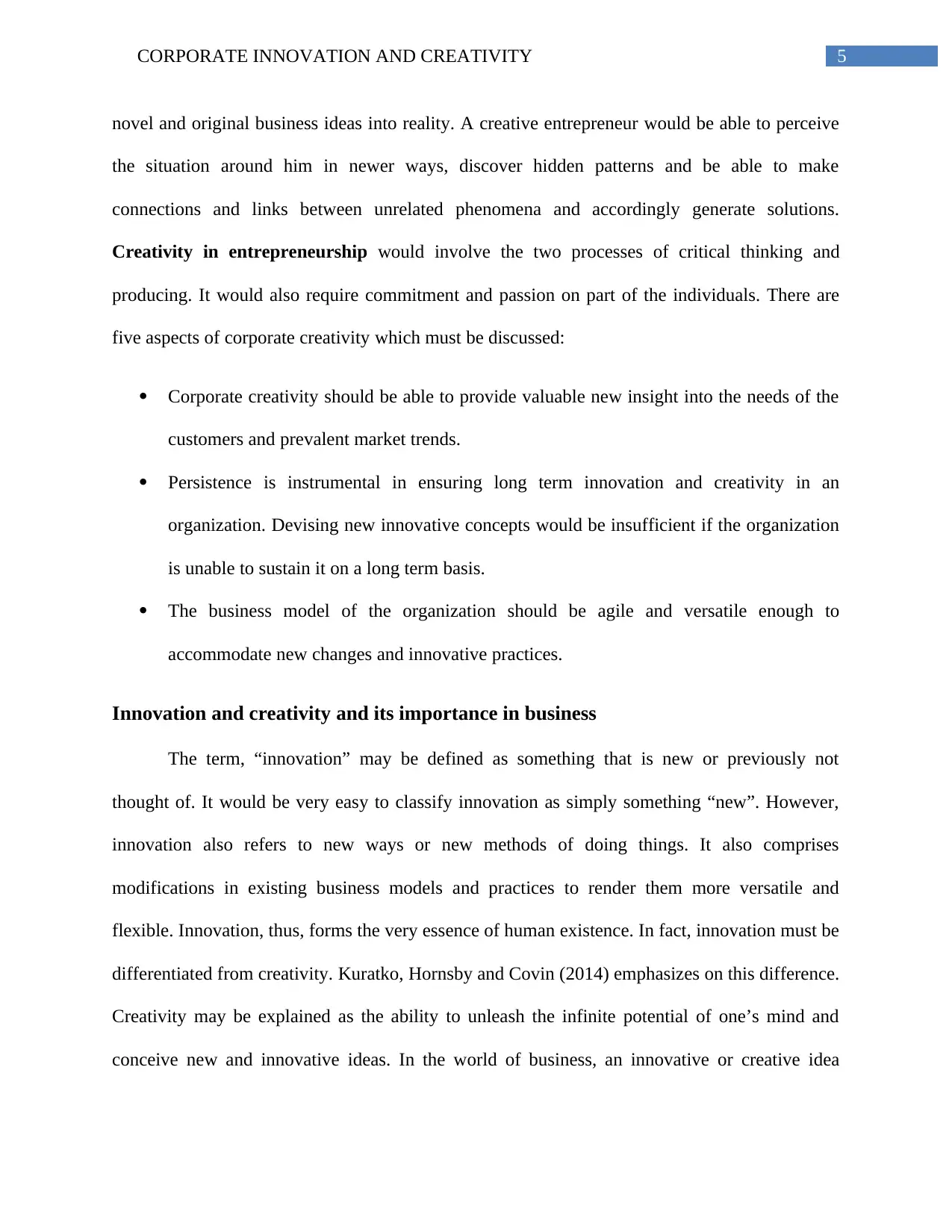
5CORPORATE INNOVATION AND CREATIVITY
novel and original business ideas into reality. A creative entrepreneur would be able to perceive
the situation around him in newer ways, discover hidden patterns and be able to make
connections and links between unrelated phenomena and accordingly generate solutions.
Creativity in entrepreneurship would involve the two processes of critical thinking and
producing. It would also require commitment and passion on part of the individuals. There are
five aspects of corporate creativity which must be discussed:
Corporate creativity should be able to provide valuable new insight into the needs of the
customers and prevalent market trends.
Persistence is instrumental in ensuring long term innovation and creativity in an
organization. Devising new innovative concepts would be insufficient if the organization
is unable to sustain it on a long term basis.
The business model of the organization should be agile and versatile enough to
accommodate new changes and innovative practices.
Innovation and creativity and its importance in business
The term, “innovation” may be defined as something that is new or previously not
thought of. It would be very easy to classify innovation as simply something “new”. However,
innovation also refers to new ways or new methods of doing things. It also comprises
modifications in existing business models and practices to render them more versatile and
flexible. Innovation, thus, forms the very essence of human existence. In fact, innovation must be
differentiated from creativity. Kuratko, Hornsby and Covin (2014) emphasizes on this difference.
Creativity may be explained as the ability to unleash the infinite potential of one’s mind and
conceive new and innovative ideas. In the world of business, an innovative or creative idea
novel and original business ideas into reality. A creative entrepreneur would be able to perceive
the situation around him in newer ways, discover hidden patterns and be able to make
connections and links between unrelated phenomena and accordingly generate solutions.
Creativity in entrepreneurship would involve the two processes of critical thinking and
producing. It would also require commitment and passion on part of the individuals. There are
five aspects of corporate creativity which must be discussed:
Corporate creativity should be able to provide valuable new insight into the needs of the
customers and prevalent market trends.
Persistence is instrumental in ensuring long term innovation and creativity in an
organization. Devising new innovative concepts would be insufficient if the organization
is unable to sustain it on a long term basis.
The business model of the organization should be agile and versatile enough to
accommodate new changes and innovative practices.
Innovation and creativity and its importance in business
The term, “innovation” may be defined as something that is new or previously not
thought of. It would be very easy to classify innovation as simply something “new”. However,
innovation also refers to new ways or new methods of doing things. It also comprises
modifications in existing business models and practices to render them more versatile and
flexible. Innovation, thus, forms the very essence of human existence. In fact, innovation must be
differentiated from creativity. Kuratko, Hornsby and Covin (2014) emphasizes on this difference.
Creativity may be explained as the ability to unleash the infinite potential of one’s mind and
conceive new and innovative ideas. In the world of business, an innovative or creative idea
⊘ This is a preview!⊘
Do you want full access?
Subscribe today to unlock all pages.

Trusted by 1+ million students worldwide
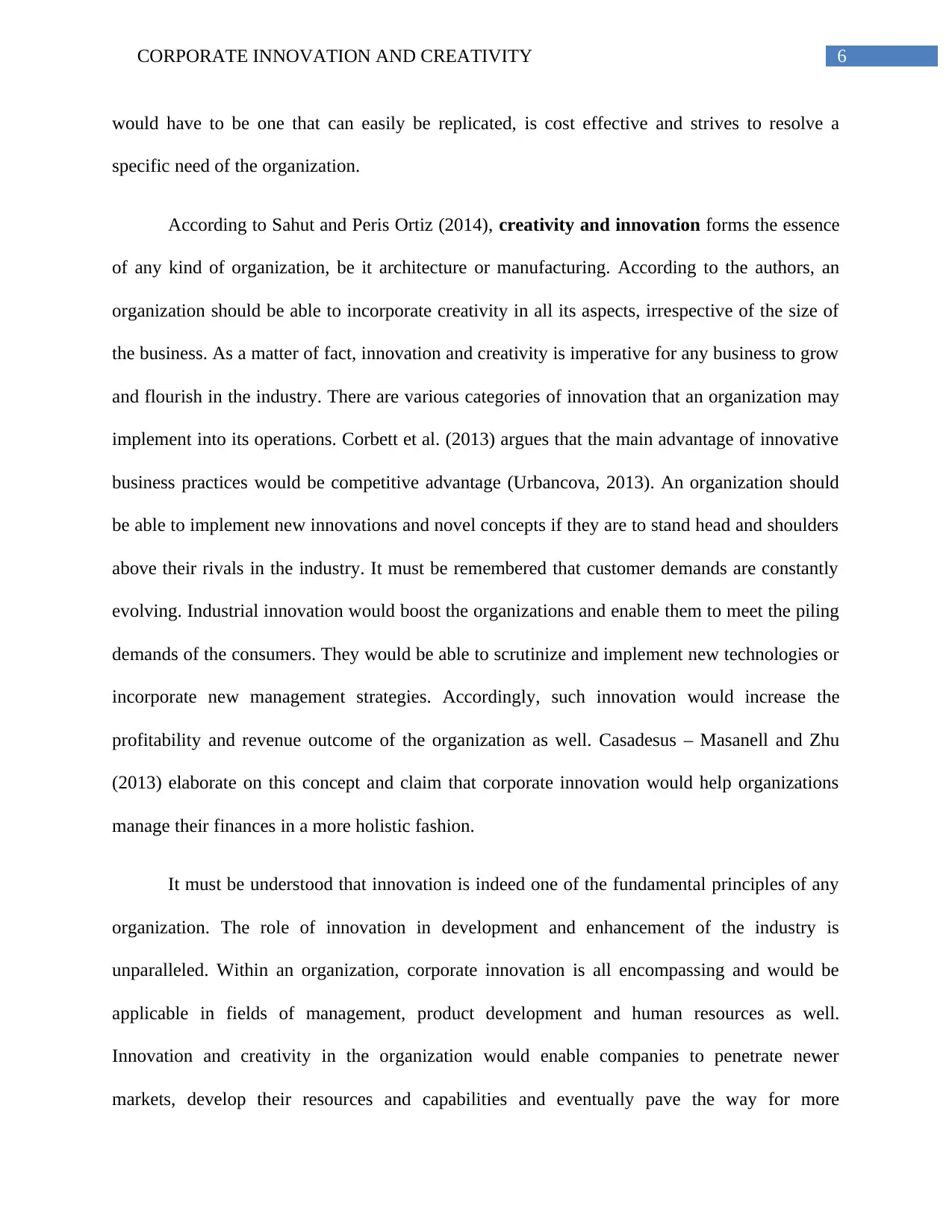
6CORPORATE INNOVATION AND CREATIVITY
would have to be one that can easily be replicated, is cost effective and strives to resolve a
specific need of the organization.
According to Sahut and Peris Ortiz (2014), creativity and innovation forms the essence
of any kind of organization, be it architecture or manufacturing. According to the authors, an
organization should be able to incorporate creativity in all its aspects, irrespective of the size of
the business. As a matter of fact, innovation and creativity is imperative for any business to grow
and flourish in the industry. There are various categories of innovation that an organization may
implement into its operations. Corbett et al. (2013) argues that the main advantage of innovative
business practices would be competitive advantage (Urbancova, 2013). An organization should
be able to implement new innovations and novel concepts if they are to stand head and shoulders
above their rivals in the industry. It must be remembered that customer demands are constantly
evolving. Industrial innovation would boost the organizations and enable them to meet the piling
demands of the consumers. They would be able to scrutinize and implement new technologies or
incorporate new management strategies. Accordingly, such innovation would increase the
profitability and revenue outcome of the organization as well. Casadesus – Masanell and Zhu
(2013) elaborate on this concept and claim that corporate innovation would help organizations
manage their finances in a more holistic fashion.
It must be understood that innovation is indeed one of the fundamental principles of any
organization. The role of innovation in development and enhancement of the industry is
unparalleled. Within an organization, corporate innovation is all encompassing and would be
applicable in fields of management, product development and human resources as well.
Innovation and creativity in the organization would enable companies to penetrate newer
markets, develop their resources and capabilities and eventually pave the way for more
would have to be one that can easily be replicated, is cost effective and strives to resolve a
specific need of the organization.
According to Sahut and Peris Ortiz (2014), creativity and innovation forms the essence
of any kind of organization, be it architecture or manufacturing. According to the authors, an
organization should be able to incorporate creativity in all its aspects, irrespective of the size of
the business. As a matter of fact, innovation and creativity is imperative for any business to grow
and flourish in the industry. There are various categories of innovation that an organization may
implement into its operations. Corbett et al. (2013) argues that the main advantage of innovative
business practices would be competitive advantage (Urbancova, 2013). An organization should
be able to implement new innovations and novel concepts if they are to stand head and shoulders
above their rivals in the industry. It must be remembered that customer demands are constantly
evolving. Industrial innovation would boost the organizations and enable them to meet the piling
demands of the consumers. They would be able to scrutinize and implement new technologies or
incorporate new management strategies. Accordingly, such innovation would increase the
profitability and revenue outcome of the organization as well. Casadesus – Masanell and Zhu
(2013) elaborate on this concept and claim that corporate innovation would help organizations
manage their finances in a more holistic fashion.
It must be understood that innovation is indeed one of the fundamental principles of any
organization. The role of innovation in development and enhancement of the industry is
unparalleled. Within an organization, corporate innovation is all encompassing and would be
applicable in fields of management, product development and human resources as well.
Innovation and creativity in the organization would enable companies to penetrate newer
markets, develop their resources and capabilities and eventually pave the way for more
Paraphrase This Document
Need a fresh take? Get an instant paraphrase of this document with our AI Paraphraser
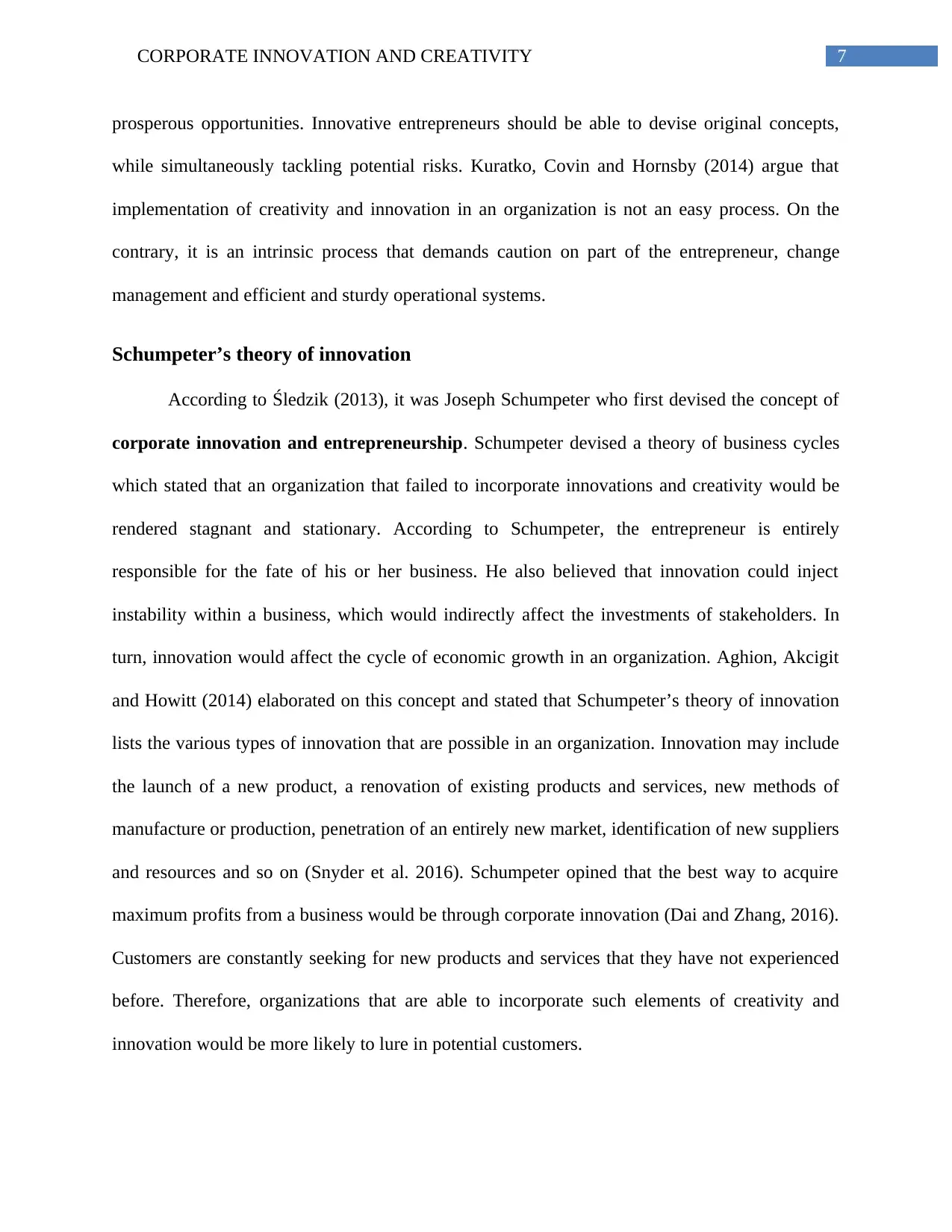
7CORPORATE INNOVATION AND CREATIVITY
prosperous opportunities. Innovative entrepreneurs should be able to devise original concepts,
while simultaneously tackling potential risks. Kuratko, Covin and Hornsby (2014) argue that
implementation of creativity and innovation in an organization is not an easy process. On the
contrary, it is an intrinsic process that demands caution on part of the entrepreneur, change
management and efficient and sturdy operational systems.
Schumpeter’s theory of innovation
According to Śledzik (2013), it was Joseph Schumpeter who first devised the concept of
corporate innovation and entrepreneurship. Schumpeter devised a theory of business cycles
which stated that an organization that failed to incorporate innovations and creativity would be
rendered stagnant and stationary. According to Schumpeter, the entrepreneur is entirely
responsible for the fate of his or her business. He also believed that innovation could inject
instability within a business, which would indirectly affect the investments of stakeholders. In
turn, innovation would affect the cycle of economic growth in an organization. Aghion, Akcigit
and Howitt (2014) elaborated on this concept and stated that Schumpeter’s theory of innovation
lists the various types of innovation that are possible in an organization. Innovation may include
the launch of a new product, a renovation of existing products and services, new methods of
manufacture or production, penetration of an entirely new market, identification of new suppliers
and resources and so on (Snyder et al. 2016). Schumpeter opined that the best way to acquire
maximum profits from a business would be through corporate innovation (Dai and Zhang, 2016).
Customers are constantly seeking for new products and services that they have not experienced
before. Therefore, organizations that are able to incorporate such elements of creativity and
innovation would be more likely to lure in potential customers.
prosperous opportunities. Innovative entrepreneurs should be able to devise original concepts,
while simultaneously tackling potential risks. Kuratko, Covin and Hornsby (2014) argue that
implementation of creativity and innovation in an organization is not an easy process. On the
contrary, it is an intrinsic process that demands caution on part of the entrepreneur, change
management and efficient and sturdy operational systems.
Schumpeter’s theory of innovation
According to Śledzik (2013), it was Joseph Schumpeter who first devised the concept of
corporate innovation and entrepreneurship. Schumpeter devised a theory of business cycles
which stated that an organization that failed to incorporate innovations and creativity would be
rendered stagnant and stationary. According to Schumpeter, the entrepreneur is entirely
responsible for the fate of his or her business. He also believed that innovation could inject
instability within a business, which would indirectly affect the investments of stakeholders. In
turn, innovation would affect the cycle of economic growth in an organization. Aghion, Akcigit
and Howitt (2014) elaborated on this concept and stated that Schumpeter’s theory of innovation
lists the various types of innovation that are possible in an organization. Innovation may include
the launch of a new product, a renovation of existing products and services, new methods of
manufacture or production, penetration of an entirely new market, identification of new suppliers
and resources and so on (Snyder et al. 2016). Schumpeter opined that the best way to acquire
maximum profits from a business would be through corporate innovation (Dai and Zhang, 2016).
Customers are constantly seeking for new products and services that they have not experienced
before. Therefore, organizations that are able to incorporate such elements of creativity and
innovation would be more likely to lure in potential customers.
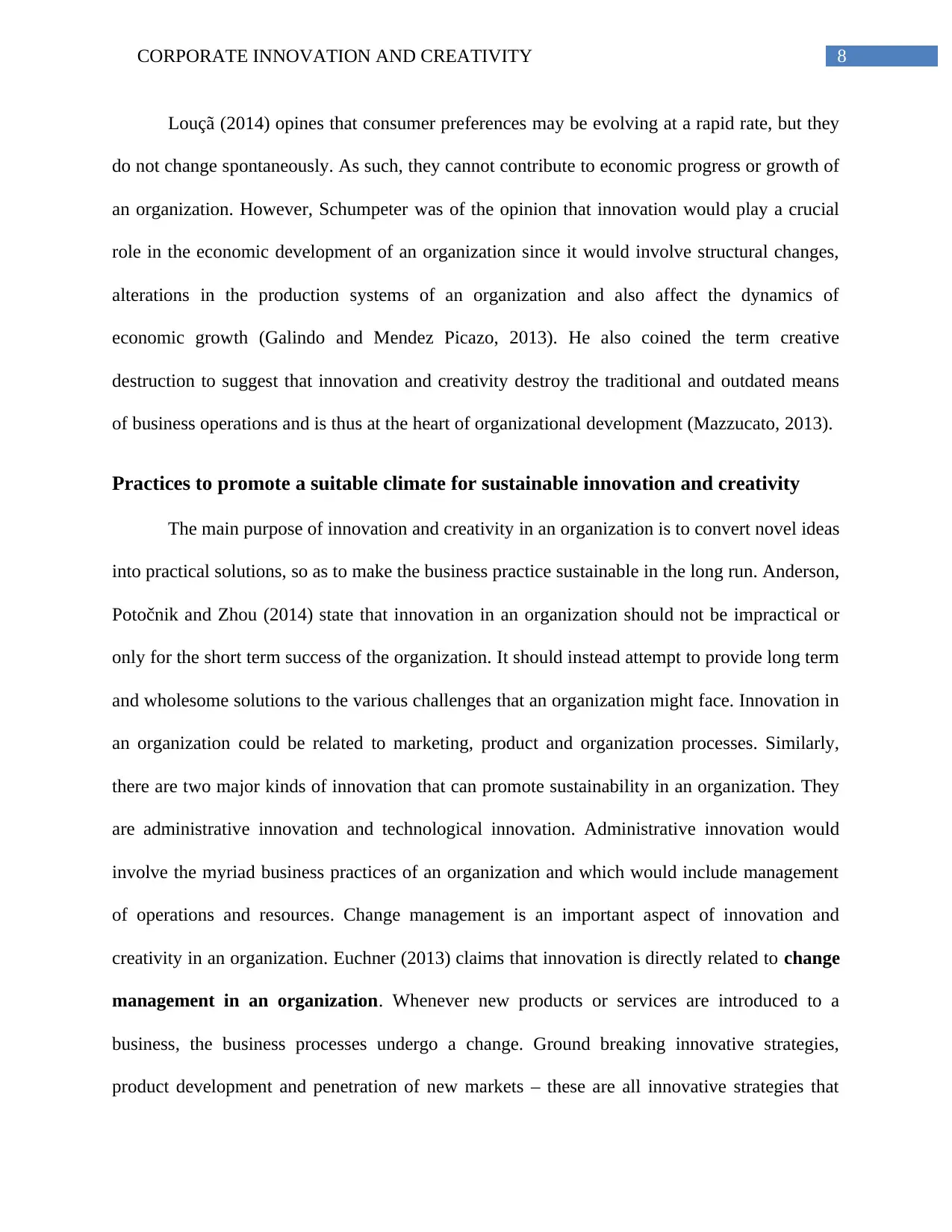
8CORPORATE INNOVATION AND CREATIVITY
Louçã (2014) opines that consumer preferences may be evolving at a rapid rate, but they
do not change spontaneously. As such, they cannot contribute to economic progress or growth of
an organization. However, Schumpeter was of the opinion that innovation would play a crucial
role in the economic development of an organization since it would involve structural changes,
alterations in the production systems of an organization and also affect the dynamics of
economic growth (Galindo and Mendez Picazo, 2013). He also coined the term creative
destruction to suggest that innovation and creativity destroy the traditional and outdated means
of business operations and is thus at the heart of organizational development (Mazzucato, 2013).
Practices to promote a suitable climate for sustainable innovation and creativity
The main purpose of innovation and creativity in an organization is to convert novel ideas
into practical solutions, so as to make the business practice sustainable in the long run. Anderson,
Potočnik and Zhou (2014) state that innovation in an organization should not be impractical or
only for the short term success of the organization. It should instead attempt to provide long term
and wholesome solutions to the various challenges that an organization might face. Innovation in
an organization could be related to marketing, product and organization processes. Similarly,
there are two major kinds of innovation that can promote sustainability in an organization. They
are administrative innovation and technological innovation. Administrative innovation would
involve the myriad business practices of an organization and which would include management
of operations and resources. Change management is an important aspect of innovation and
creativity in an organization. Euchner (2013) claims that innovation is directly related to change
management in an organization. Whenever new products or services are introduced to a
business, the business processes undergo a change. Ground breaking innovative strategies,
product development and penetration of new markets – these are all innovative strategies that
Louçã (2014) opines that consumer preferences may be evolving at a rapid rate, but they
do not change spontaneously. As such, they cannot contribute to economic progress or growth of
an organization. However, Schumpeter was of the opinion that innovation would play a crucial
role in the economic development of an organization since it would involve structural changes,
alterations in the production systems of an organization and also affect the dynamics of
economic growth (Galindo and Mendez Picazo, 2013). He also coined the term creative
destruction to suggest that innovation and creativity destroy the traditional and outdated means
of business operations and is thus at the heart of organizational development (Mazzucato, 2013).
Practices to promote a suitable climate for sustainable innovation and creativity
The main purpose of innovation and creativity in an organization is to convert novel ideas
into practical solutions, so as to make the business practice sustainable in the long run. Anderson,
Potočnik and Zhou (2014) state that innovation in an organization should not be impractical or
only for the short term success of the organization. It should instead attempt to provide long term
and wholesome solutions to the various challenges that an organization might face. Innovation in
an organization could be related to marketing, product and organization processes. Similarly,
there are two major kinds of innovation that can promote sustainability in an organization. They
are administrative innovation and technological innovation. Administrative innovation would
involve the myriad business practices of an organization and which would include management
of operations and resources. Change management is an important aspect of innovation and
creativity in an organization. Euchner (2013) claims that innovation is directly related to change
management in an organization. Whenever new products or services are introduced to a
business, the business processes undergo a change. Ground breaking innovative strategies,
product development and penetration of new markets – these are all innovative strategies that
⊘ This is a preview!⊘
Do you want full access?
Subscribe today to unlock all pages.

Trusted by 1+ million students worldwide
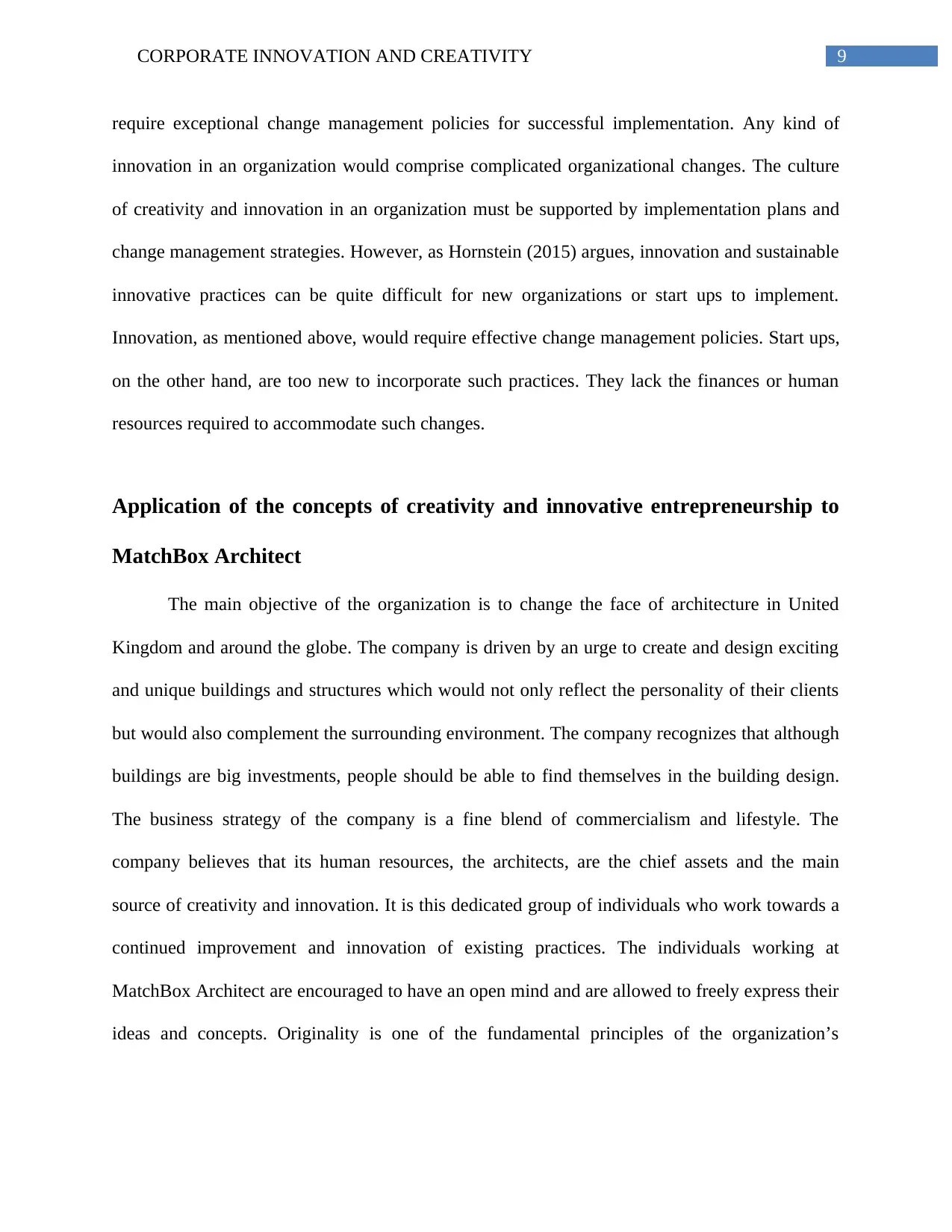
9CORPORATE INNOVATION AND CREATIVITY
require exceptional change management policies for successful implementation. Any kind of
innovation in an organization would comprise complicated organizational changes. The culture
of creativity and innovation in an organization must be supported by implementation plans and
change management strategies. However, as Hornstein (2015) argues, innovation and sustainable
innovative practices can be quite difficult for new organizations or start ups to implement.
Innovation, as mentioned above, would require effective change management policies. Start ups,
on the other hand, are too new to incorporate such practices. They lack the finances or human
resources required to accommodate such changes.
Application of the concepts of creativity and innovative entrepreneurship to
MatchBox Architect
The main objective of the organization is to change the face of architecture in United
Kingdom and around the globe. The company is driven by an urge to create and design exciting
and unique buildings and structures which would not only reflect the personality of their clients
but would also complement the surrounding environment. The company recognizes that although
buildings are big investments, people should be able to find themselves in the building design.
The business strategy of the company is a fine blend of commercialism and lifestyle. The
company believes that its human resources, the architects, are the chief assets and the main
source of creativity and innovation. It is this dedicated group of individuals who work towards a
continued improvement and innovation of existing practices. The individuals working at
MatchBox Architect are encouraged to have an open mind and are allowed to freely express their
ideas and concepts. Originality is one of the fundamental principles of the organization’s
require exceptional change management policies for successful implementation. Any kind of
innovation in an organization would comprise complicated organizational changes. The culture
of creativity and innovation in an organization must be supported by implementation plans and
change management strategies. However, as Hornstein (2015) argues, innovation and sustainable
innovative practices can be quite difficult for new organizations or start ups to implement.
Innovation, as mentioned above, would require effective change management policies. Start ups,
on the other hand, are too new to incorporate such practices. They lack the finances or human
resources required to accommodate such changes.
Application of the concepts of creativity and innovative entrepreneurship to
MatchBox Architect
The main objective of the organization is to change the face of architecture in United
Kingdom and around the globe. The company is driven by an urge to create and design exciting
and unique buildings and structures which would not only reflect the personality of their clients
but would also complement the surrounding environment. The company recognizes that although
buildings are big investments, people should be able to find themselves in the building design.
The business strategy of the company is a fine blend of commercialism and lifestyle. The
company believes that its human resources, the architects, are the chief assets and the main
source of creativity and innovation. It is this dedicated group of individuals who work towards a
continued improvement and innovation of existing practices. The individuals working at
MatchBox Architect are encouraged to have an open mind and are allowed to freely express their
ideas and concepts. Originality is one of the fundamental principles of the organization’s
Paraphrase This Document
Need a fresh take? Get an instant paraphrase of this document with our AI Paraphraser
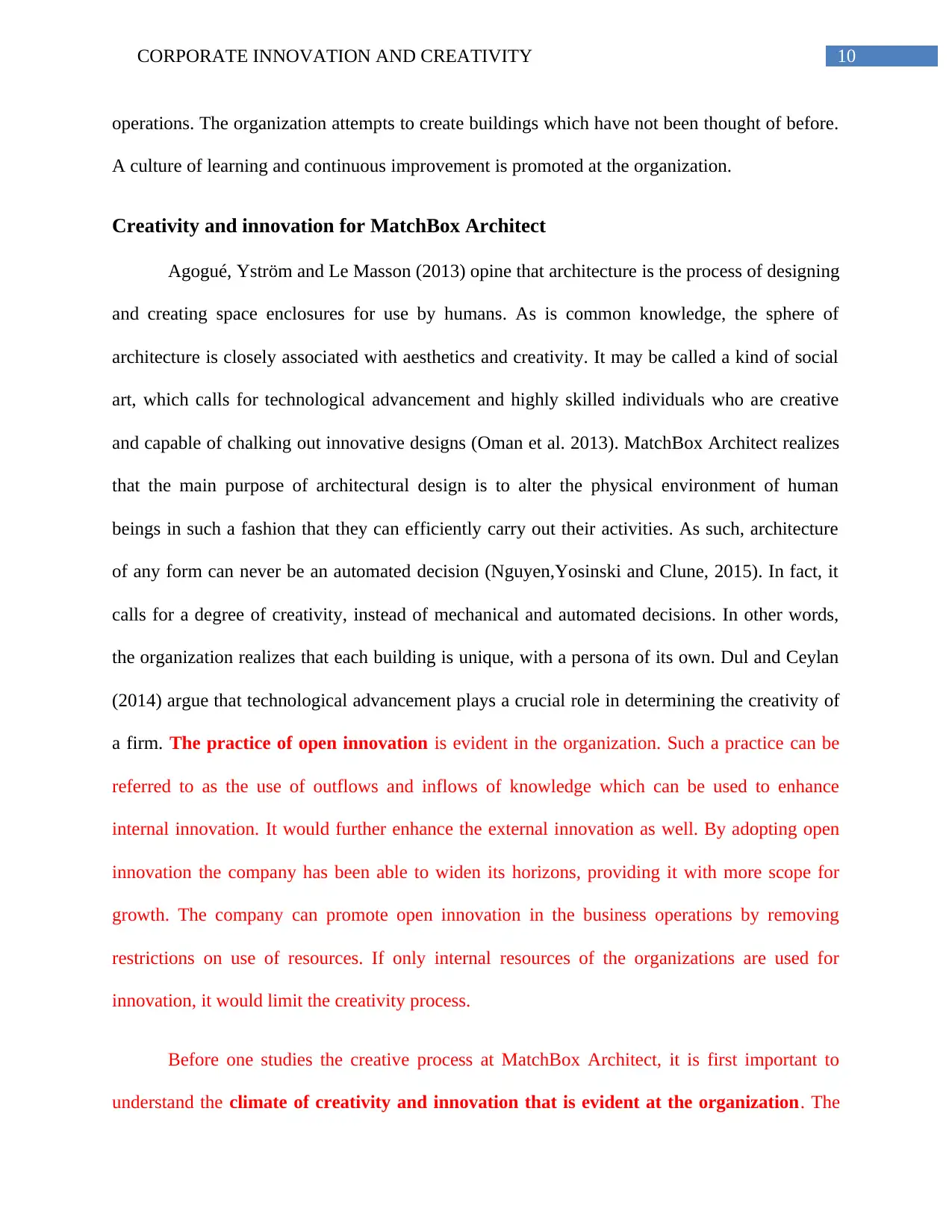
10CORPORATE INNOVATION AND CREATIVITY
operations. The organization attempts to create buildings which have not been thought of before.
A culture of learning and continuous improvement is promoted at the organization.
Creativity and innovation for MatchBox Architect
Agogué, Yström and Le Masson (2013) opine that architecture is the process of designing
and creating space enclosures for use by humans. As is common knowledge, the sphere of
architecture is closely associated with aesthetics and creativity. It may be called a kind of social
art, which calls for technological advancement and highly skilled individuals who are creative
and capable of chalking out innovative designs (Oman et al. 2013). MatchBox Architect realizes
that the main purpose of architectural design is to alter the physical environment of human
beings in such a fashion that they can efficiently carry out their activities. As such, architecture
of any form can never be an automated decision (Nguyen,Yosinski and Clune, 2015). In fact, it
calls for a degree of creativity, instead of mechanical and automated decisions. In other words,
the organization realizes that each building is unique, with a persona of its own. Dul and Ceylan
(2014) argue that technological advancement plays a crucial role in determining the creativity of
a firm. The practice of open innovation is evident in the organization. Such a practice can be
referred to as the use of outflows and inflows of knowledge which can be used to enhance
internal innovation. It would further enhance the external innovation as well. By adopting open
innovation the company has been able to widen its horizons, providing it with more scope for
growth. The company can promote open innovation in the business operations by removing
restrictions on use of resources. If only internal resources of the organizations are used for
innovation, it would limit the creativity process.
Before one studies the creative process at MatchBox Architect, it is first important to
understand the climate of creativity and innovation that is evident at the organization. The
operations. The organization attempts to create buildings which have not been thought of before.
A culture of learning and continuous improvement is promoted at the organization.
Creativity and innovation for MatchBox Architect
Agogué, Yström and Le Masson (2013) opine that architecture is the process of designing
and creating space enclosures for use by humans. As is common knowledge, the sphere of
architecture is closely associated with aesthetics and creativity. It may be called a kind of social
art, which calls for technological advancement and highly skilled individuals who are creative
and capable of chalking out innovative designs (Oman et al. 2013). MatchBox Architect realizes
that the main purpose of architectural design is to alter the physical environment of human
beings in such a fashion that they can efficiently carry out their activities. As such, architecture
of any form can never be an automated decision (Nguyen,Yosinski and Clune, 2015). In fact, it
calls for a degree of creativity, instead of mechanical and automated decisions. In other words,
the organization realizes that each building is unique, with a persona of its own. Dul and Ceylan
(2014) argue that technological advancement plays a crucial role in determining the creativity of
a firm. The practice of open innovation is evident in the organization. Such a practice can be
referred to as the use of outflows and inflows of knowledge which can be used to enhance
internal innovation. It would further enhance the external innovation as well. By adopting open
innovation the company has been able to widen its horizons, providing it with more scope for
growth. The company can promote open innovation in the business operations by removing
restrictions on use of resources. If only internal resources of the organizations are used for
innovation, it would limit the creativity process.
Before one studies the creative process at MatchBox Architect, it is first important to
understand the climate of creativity and innovation that is evident at the organization. The
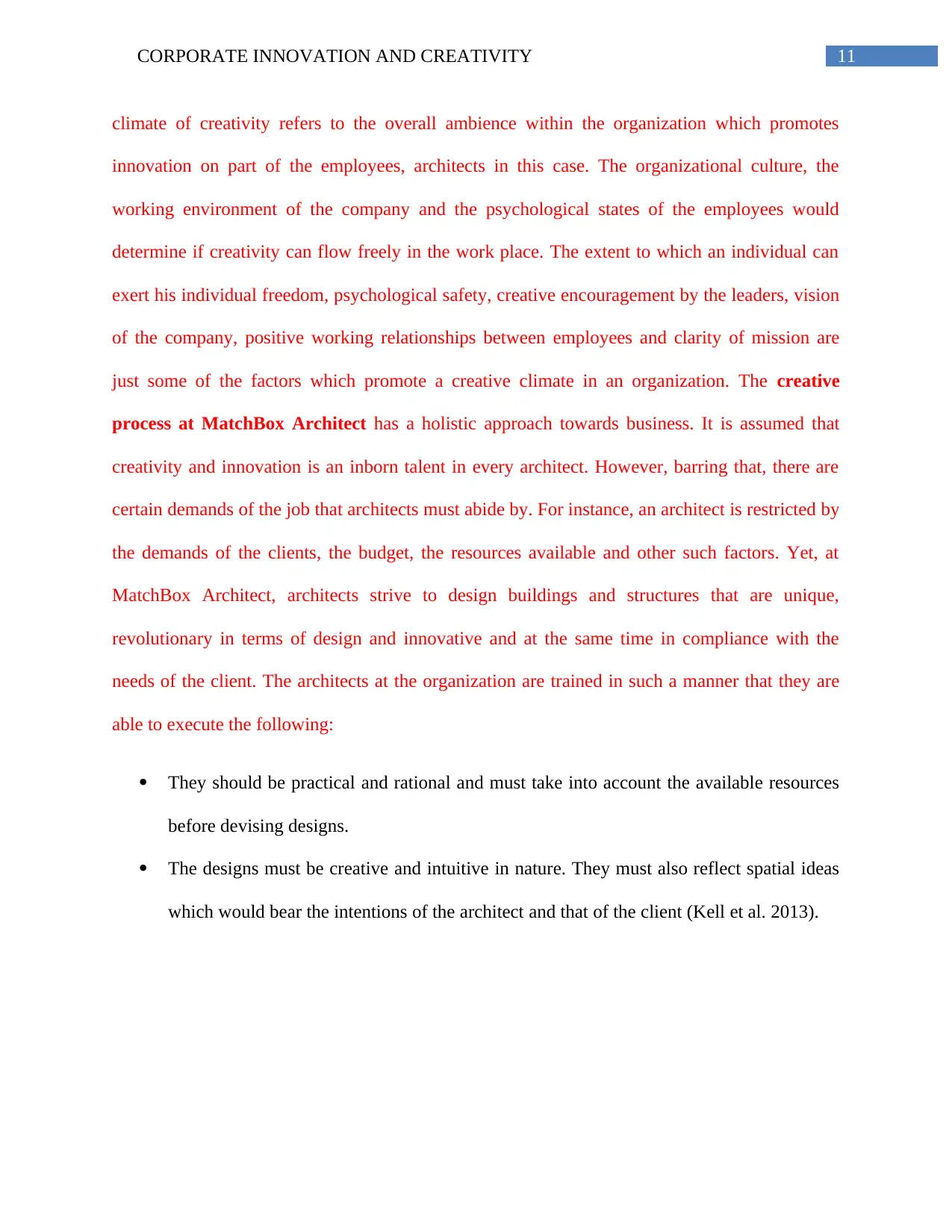
11CORPORATE INNOVATION AND CREATIVITY
climate of creativity refers to the overall ambience within the organization which promotes
innovation on part of the employees, architects in this case. The organizational culture, the
working environment of the company and the psychological states of the employees would
determine if creativity can flow freely in the work place. The extent to which an individual can
exert his individual freedom, psychological safety, creative encouragement by the leaders, vision
of the company, positive working relationships between employees and clarity of mission are
just some of the factors which promote a creative climate in an organization. The creative
process at MatchBox Architect has a holistic approach towards business. It is assumed that
creativity and innovation is an inborn talent in every architect. However, barring that, there are
certain demands of the job that architects must abide by. For instance, an architect is restricted by
the demands of the clients, the budget, the resources available and other such factors. Yet, at
MatchBox Architect, architects strive to design buildings and structures that are unique,
revolutionary in terms of design and innovative and at the same time in compliance with the
needs of the client. The architects at the organization are trained in such a manner that they are
able to execute the following:
They should be practical and rational and must take into account the available resources
before devising designs.
The designs must be creative and intuitive in nature. They must also reflect spatial ideas
which would bear the intentions of the architect and that of the client (Kell et al. 2013).
climate of creativity refers to the overall ambience within the organization which promotes
innovation on part of the employees, architects in this case. The organizational culture, the
working environment of the company and the psychological states of the employees would
determine if creativity can flow freely in the work place. The extent to which an individual can
exert his individual freedom, psychological safety, creative encouragement by the leaders, vision
of the company, positive working relationships between employees and clarity of mission are
just some of the factors which promote a creative climate in an organization. The creative
process at MatchBox Architect has a holistic approach towards business. It is assumed that
creativity and innovation is an inborn talent in every architect. However, barring that, there are
certain demands of the job that architects must abide by. For instance, an architect is restricted by
the demands of the clients, the budget, the resources available and other such factors. Yet, at
MatchBox Architect, architects strive to design buildings and structures that are unique,
revolutionary in terms of design and innovative and at the same time in compliance with the
needs of the client. The architects at the organization are trained in such a manner that they are
able to execute the following:
They should be practical and rational and must take into account the available resources
before devising designs.
The designs must be creative and intuitive in nature. They must also reflect spatial ideas
which would bear the intentions of the architect and that of the client (Kell et al. 2013).
⊘ This is a preview!⊘
Do you want full access?
Subscribe today to unlock all pages.

Trusted by 1+ million students worldwide
1 out of 21
Related Documents
Your All-in-One AI-Powered Toolkit for Academic Success.
+13062052269
info@desklib.com
Available 24*7 on WhatsApp / Email
![[object Object]](/_next/static/media/star-bottom.7253800d.svg)
Unlock your academic potential
Copyright © 2020–2025 A2Z Services. All Rights Reserved. Developed and managed by ZUCOL.





